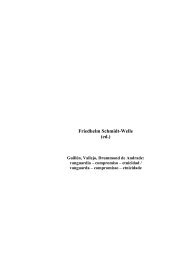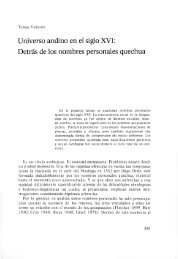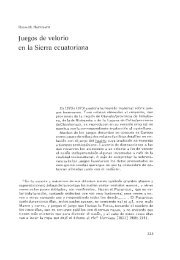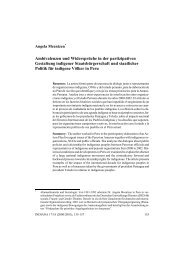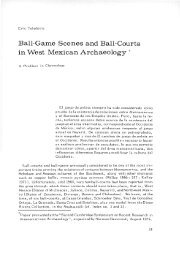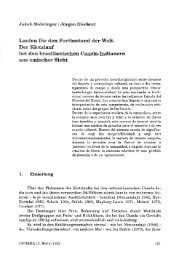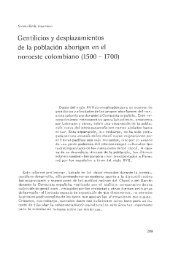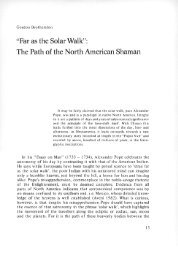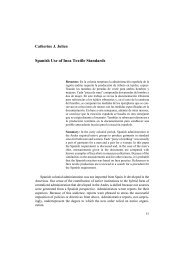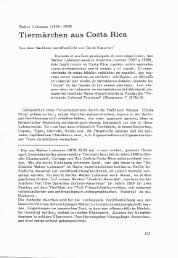Time and Script in Ancient Mesoamerica
Time and Script in Ancient Mesoamerica
Time and Script in Ancient Mesoamerica
Create successful ePaper yourself
Turn your PDF publications into a flip-book with our unique Google optimized e-Paper software.
<strong>in</strong> post-E<strong>in</strong>ste<strong>in</strong> cosmologies. This co<strong>in</strong>cidence of focus is unfortunate <strong>in</strong>sofar<br />
as it can obscure the difference between a 'fourth' <strong>and</strong> a first dimension.<br />
Whatever logical statements may or may not be made about time <strong>and</strong> space<br />
as universal concepts, it is clear that <strong>in</strong> the Western tradition scientific measurement<br />
of the one has been <strong>in</strong>timately related to that of the other. The sexigesimal<br />
system of m<strong>in</strong>utes <strong>and</strong> seconds which the Babylonians <strong>in</strong>itially derived<br />
from celestial co-ord<strong>in</strong>ates still has a temporal as well as a spatial<br />
application. Similarly, much of Lucas's flourish <strong>in</strong> favour of time would be<br />
lost if geometry had never existed. For the ancient <strong>Mesoamerica</strong>ns, however,<br />
time, <strong>and</strong> time only, was scientifically everyth<strong>in</strong>g from the start. Elsewhere<br />
(Brotherston <strong>and</strong> Ades 1975; Brotherston 1975a) we have shown that as<br />
the only tropical astronomers on the planet they had no verifiable card<strong>in</strong>al<br />
po<strong>in</strong>ts, <strong>and</strong> that their cosmos lacked reliable spatial co-ord<strong>in</strong>ates, <strong>and</strong> certa<strong>in</strong>ly<br />
all geometry. Indeed, the notion of 'po<strong>in</strong>ts' <strong>and</strong> 'l<strong>in</strong>es or spaces between'<br />
. <strong>in</strong> the strict sense, was foreign to them. Cassirer (1964: 107), for<br />
example, derives the Old World concept of spatial or temporal <strong>in</strong>terval from<br />
the <strong>in</strong>tersect<strong>in</strong>g of the sun's east-west l<strong>in</strong>e by that 'perpendicular runn<strong>in</strong>g<br />
from north to south' which the <strong>Mesoamerica</strong>ns never drew.<br />
Hav<strong>in</strong>g no place to st<strong>and</strong> (Archimedes: 'Give me somewhere to st<strong>and</strong> <strong>and</strong><br />
I will move the universe'), the <strong>Mesoamerica</strong>ns had other'grounds' for knowledge<br />
<strong>and</strong> an epistemology that was restricted to their one 'dimension', the s<strong>in</strong>gle,<br />
temporal east-west direction. Hence that enormous concentration of<br />
thought <strong>in</strong>to time. While undivided <strong>and</strong> unmeasured <strong>in</strong> our terms, time was<br />
however systematically expressed <strong>in</strong> the notations of calendar arithmetic<br />
<strong>and</strong> astronomy. As a result, what might appear to us to be casual or r<strong>and</strong>om<br />
'variations' <strong>in</strong> these notations, as local or idiosyncratic 'usages' with<strong>in</strong><strong>Mesoamerica</strong>,<br />
will <strong>in</strong> fact sooner reveal logical dist<strong>in</strong>ctions, the consequences<br />
of which we may explore.<br />
Our advantage <strong>in</strong> this matter is that such 'variations' may be very f<strong>in</strong>ely<br />
gauged because certa<strong>in</strong> methods of reckon<strong>in</strong>g time, notably by means of<br />
the 'Calendar Round' of 52 years, were used by many different peoples <strong>in</strong><br />
<strong>Mesoamerica</strong> <strong>and</strong> can be traced back well <strong>in</strong>to the first milennium B.C. Our<br />
disadvantage is that pre-Columbian source material is most unevenly spread<br />
between these peoples, <strong>and</strong> that very scanty evidence rema<strong>in</strong>s of the nature<br />
of the earliest calendars, of the Olmec, the Zapotee, <strong>and</strong> the pre-classic<br />
Maya. Thus, while this enquiry by no means pretends to cover all known conventions<br />
of time reckon<strong>in</strong>g <strong>in</strong> the <strong>Mesoamerica</strong>n area, the pre-Toltec calendar<br />
of the Southern Zapotee, for example, or the Mava 'Short Count',<br />
it does seek to place <strong>and</strong> contrast conventions which are apparently similar.<br />
The ma<strong>in</strong> reason for do<strong>in</strong>g this is to exam<strong>in</strong>e the connection between time<br />
record<strong>in</strong>g <strong>and</strong> script, which Barthel (1968: 283) has called 'noth<strong>in</strong>g less than<br />
def<strong>in</strong><strong>in</strong>g criterion of <strong>Ancient</strong> Mexico'. The approach may perhaps be premature,<br />
<strong>in</strong> view of the grow<strong>in</strong>g discoveries of 'proto-scripts' at Teotihuacan,<br />
10



